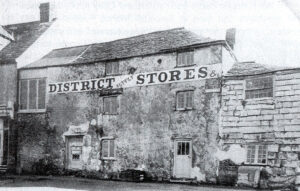 John Hockin’s corn store along the Strand, Bude.
John Hockin’s corn store along the Strand, Bude.
Alan McIntosh brings us the story of how the members of the Edwards family progressed from being lowly employed labourers to owning businesses involved in the early development of Bude’s trade.
Research shows that the Edwards family probably came to Cornwall by links with the coastal trade from Wales. The Bude connection came through John Edwards, born in St Gennys parish in 1788. He served in the British Army for 20 years, fought in the Napoleonic wars and was awarded a pension from the Royal Hospital, Chelsea, as an Out Pensioner. John was married in 1832 to Mary Bone of St Gennys and their first son, also John, born in 1834, and the eldest of six children, worked in the parish as a farm labourer at West Dizzard Farm. The family, being of the labouring class, education was beyond their reach, therefore John could not read or write.
During the 1850s, young John would walk to Bude on a Sunday to meet Ann Pearse whose father was a wagoner from Launcells. Eventually John and Ann were married, in 1857, and moved to Bude where he started work as a merchant’s yardsman for Hockin and Hooper. Ann’s father, James Pearse was already working there as a wagoner.
John Hockin came from a Hartland Quay family of shipowners and merchants and lived in Broomhill Manor, Poughill. In 1821, his business occupied the entire block of warehouses and cottages along Bude Strand where he was later joined by Henry Hooper to form the company of Hockin and Hooper.
As the business expanded, the manager, Mr J W W Banbury, acquired a share in the firm which then became known as Hockin and Banbury.
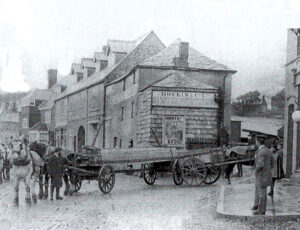 Timber waggon leaving Hockin and Hooper, Strand, Bude.
Timber waggon leaving Hockin and Hooper, Strand, Bude.
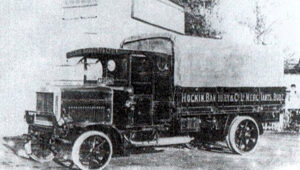 Hockin and Banbury Lorry.
Hockin and Banbury Lorry.
The business imported large baulks of timber which were unloaded on the beach and towed up the river at high tide, under the square arch of Nanny Moore’s Bridge, to be cut up into boards at the workshop.
As another enterprise, John Hockin leased the lime kiln on the Higher Wharf along the Bude Canal from Sir Thomas Dyke Ackland and employed John Edwards as a lime burner. This job would have a better wage and included number 2 Lime Kiln Cottages into which John and Ann set up home circa 1870.
Lime burning was one of the most unpleasant and exhausting jobs available, but with a growing family, a job was a job. Although the sea sand from Bude had a high lime content and was transported in land by the canal for enriching the land, burnt limestone was in demand for the building industry, being a constituent in the making of mortar and for lime washing. Cattle sheds, farm buildings and privies were lime washed regularly to prevent infection.
By the 1880s, lime could be transported cheaper by ship or by the railway which by that time, had reached Holsworthy and the use of the line kiln became unprofitable.
The coming of the railway, firstly as far as Holsworthy and then extending to Bude, brought big changes. The workings of the canal became obsolete and coastal shipping declined. Bude was now accessible and was becoming a popular holiday resort with its sandy beaches and fresh sea air. This in turn involved some large building projects for accommodation, and in 1880 one of the prominent land owners, Francis John Thynne, employed John and Samuel Pethick of Marhamchurch, to construct Morwenna Terrace on land he had leased for 99 years.
 2 Morwenna Terrace, where the Edwards family lived.
2 Morwenna Terrace, where the Edwards family lived.
The decline of the lime trade caused John Edwards to seek another occupation and he and his family established a posting house. The post had been brought to Bude by mail coach from Holsworthy but after 1897 it was delivered by train to Bude Station.
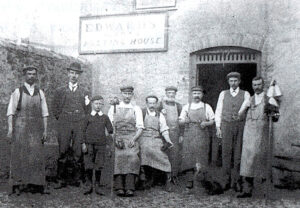 The Edwards’ Posting House.
The Edwards’ Posting House.
The posting house would hold the post horses and traps to deliver the mail to the surrounding parishes and outlying villages and also the relay horses to return the daily post van. In 1890 the Edwards family moved up to 2 Morwenna Terrace, built in 1887. The premises had stables and carriage storage at the rear and a loft for hay and forage. There was a room for sorting the mail and accommodation for a stable boy. John enlarged his business with his sons employed as post messengers and jobmasters. There was also a forge for shoeing. This enabled the family to hire out horses, with or without carriages, and to supply transport to and from the station and trips to local beauty spots.
John and Ann Edwards had thirteen children.
Mary Ann, born in 1858, married William John Skinner from Milton Dameral. They farmed 28 acres at Kitts Farm near Stratton and had three children, all girls. Mary died in 1883 giving birth to Catherine Jane. The girls were brought up by their grandparents at 2 Morwenna Terrace, Bude.
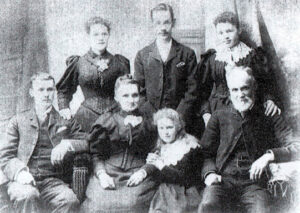 John and Ann with five of their children.
John and Ann with five of their children.
Elizabeth, born in 1860, remained a spinster and died in 1888 aged 28. She is buried with her sister, Mary Ann, in St Michael and All Angels, Budehaven.
Sarah Jane was born in 1862 and in 1888 she married William Thomas Oliver from Marhamchurch who was a boot maker and cycle agent. His shop in Othello Terrace had been built circa 1810 and named after an American ship carrying cotton, wrecked at Bude in 1808. Timber from the wreck had been used in the construction of Othello Terrace and when it was demolished in 1910, William moved to 3 Princes Street and continued as a boot maker and also repaired shoes. These premises later became N T Keat’s hardware shop.
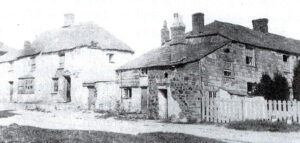 Othello Terrace – William’s shop is on the left.
Othello Terrace – William’s shop is on the left.
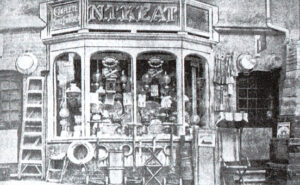 3 Princes Street – N T Keat’s shop.
3 Princes Street – N T Keat’s shop.
After the first three children, all girls, John and Ann’s first son, William, was born in 1864 but died when he was just six years old.
The next son, James Henry, born in 1866, was always called Harry. He left school when he was 12 to work with his father with the lime burning. By 1890 he was a horse driver in the post delivery, working for his father under the title of Edwards and Sons. When John died, in 1912, Harry, being the eldest son, took over the business. He rented fields for his horses at the bottom of Stratton Road/Kings Hill from the Thynne Estate. These fields where sold in 1918 to pay the death duties for Lieutenant Colonel A C Thynne who had been killed in the War. This land was bought at the auction by N T Keat for £710 and eventually Berries Mount Housing Estate was built there. In 1914, when he was 48, Harry married Elizabeth (Nell) Ellen Cook of Alford House in Summerleaze Crescent. She was the only daughter of Captain John Box Cook and his wife Elizabeth Pethick, she being sister to Samuel and John Pethick, the builders from Marhamchurch who had built Morwenna Terrace and many other buildings in Bude. In 1915, Harry and Nell had a son, Arthur J Edwards but sadly Elizabeth died in childbirth aged 31. The funeral, held in Flexbury Chapel, was the largest Bude had ever seen and, from there, she was laid to rest in St Michael and All Angels, Budehaven. Baby Arthur survived and was the first child to christened in the Flexbury Chapel font, a gift from the Pethick family who had also built the iconic chapel, a lasting memorial to the Pethick brother’s building skills. After attending Bude Elementary School, Arthur trained to be a solicitor in London.
The next sons of John and Ann, born in 1869, were twins, John and Samuel. At 12 years old they were assisting their father as lime burners. By 1890, John was employed as a mason for Pethick Brothers. He married Clara Jane Marshall in 1893 at St Gennys. While living there they had a daughter, Elsie Alberta. In 1895 they moved to 1 Burn View, Bude, where their son Francis John was born in 1901. Frank, as he was more commonly called, married Ellen Deacon in 1927. He started his business by purchasing Jimmy Broad’s toy and novelty shop on the corner of Belle Vue and Prices Street, around 1930. This building was demolished in 1938 and rebuilt by Samuel and John Pethick in art-deco style as F J Edwards Emporium. Frank and Nellie had a flat above the Emporium and on retirement they sold it to the Co-op and moved to Torquay.
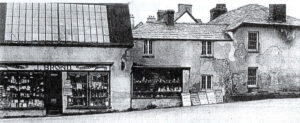 Jimmy Broad’s shop.
Jimmy Broad’s shop.
By 1890, John’s twin brother Samuel, was assisting his father in running the posting house. He married Mary Jane Rowe in 1894. They met while she was a parlour maid to Edwin Chamier, a solicitor. In 1896 Samuel Edwards started a business on his own as a jobmaster in rented stables at Flexbury Mews, which is down a back lane opposite Flexbury Chapel. With his growing business he purchased a site at the bottom of Ocean View Road where the present garage is still in operation. In 1911 he purchased the adjoining site from the Bude Land and Building Company for £120 and built Flexbury House. At that time he was listed as a Livery Stable Keeper. Samuel and Mary had one son, Harold John Glencote Edwards, in April 1895. He married Ethel Mary Pethick, a daughter of Samuel and Fanny Pethick, builders. They had no children.
With the popularity of motor vehicles, in 1920 Samuel Edwards instructed Mr W J Graver to sell by auction his jobmaster stock of two brakes, three landaus, one brougham, two Victorias and a glass hearse, together with a pair of quiet chestnut 15.2 horses. At that time he took a lease on Angrove House on Bude Strand and converted it into a garage. From there he ran charabancs and taxis with a booking office. They changed their name to Sam Edwards and Co and were advertising as motor proprietors with cars for hire from Flexbury Garage.
 Sam Edwards’ garage, Ocean View Road, Flexbury, Bude.
Sam Edwards’ garage, Ocean View Road, Flexbury, Bude.
In 1927, Sam instructed Kivell and Son to sell the Strand business with the buses and charabancs and this was purchased by the National Omnibus and Transport Company. In the 1930s, the bus company built a new garage at the top of Lansdown Road and used Angrove House as a booking office up to 1970 when the lease expired and Harold Edwards sold Angrove House to miss Julia Brooks.
Meanwhile, in 1928, Samuel built his new house, Glencott, in Creathorne Road and sold Flexbury House to his son, Harold, for £1000. He also built another block of lock-up garages at Flexbury Garage. Samuel retired in 1934 leaving the business to his son, Harold, who then made Ted Orchard and Sandy Sandercock, partners. During the Second World War the garage was used as a centre by the ARP and as a first aid post. In 1944, the American Rangers and other units arrived in Bude in preparation for the D-Day landings. One unit was equipped with two light planes which were kept in a hangar at the back of the workshops. These were wheeled out and took off and landed across the marshes behind
Harold moved to Glencott and carried on the business until his retirement in 1962 when the garage was sold to David Henry Currie. Harold was still a regular visitor to the garage in the 1980s.
 Harold Edwards, son of Sam, outside the garage in 1935 with Derek Orchard, age two, son of Ted Orchard who was managing director from 1934 to 1962. (Photo: courtesy Derek Orchard)
Harold Edwards, son of Sam, outside the garage in 1935 with Derek Orchard, age two, son of Ted Orchard who was managing director from 1934 to 1962. (Photo: courtesy Derek Orchard)
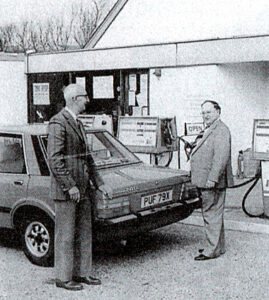 Harold and Derek circa 1983. (Photo: courtesy Derek Orchard)
Harold and Derek circa 1983. (Photo: courtesy Derek Orchard)
The fifth son of John and Ann, Frederick, was born in 1871 at Lime Cottage. Fred took on Dunsmouth Farm, Poughill and married Mary Jane Ward in 1900 but she died in childbirth in 1901 when their daughter, Annie Jane, was born. So, Fred’s younger sisters, Norah and Katie, took over the running of the farmhouse. In 1905 Fred remarried. Mary Elizabeth Burden was from a farming family at Broadwoodwidger in Devon: they had no children. Fred’s daughter Annie Jane grew up to be an organist and pianist at Bude Central Methodist Church. Fred and Mary were founder members of the new Poughill Methodist Chapel built in 1924 where Fred was also a trustee and treasurer. He was also on the Poughill School Board and was Junior Steward of the Bude and kilkhampton Circuit. They retired to Hill Crest, Poughill Road, Bude. Fred died in Bodmin in 1937, aged 65, and Mary passed away at Hill Crest on the 12th of December 1945.
Thomas, born in 1875, the youngest son of John and Ann, went to the Wesleyan school in Bude. He became a devoted member of the Wesleyans and continued his Methodist faith throughout his life being a preacher for over 40 years. He was also a trustee of Poughill Methodist Church and a founder member of the Bude branch of the Independent Order of Rechabites. He married Elizabeth Lyle Glidden from Launcells in 1899 and they had a daughter, Gladys. Soon after his father died, in 1912, Thomas and Harry continued with the business until Harry remarried and moved to London to join his son Arthur.
On the outbreak of the First World War, in 1914, the government commandeered 18 of the Edwards horses for the war in France and they were left with only one. At Dunsmouth Farm, Fred kept many horses for the farm work and these were exempt. When Tom needed horses at Morwenna, he would raise a flag on top of the stables, requesting help. On receiving the signal from his brother, Fred would send his horseman, Samuel Snowden, with the required team to Bude.
Norah Edwards, born in 1873, worked for her brother, Thomas, in the office of the family garage business. She also helped to look after Fred’s daughter, and the daughters of her sister Mary, living at 2 Morwenna Terrace with their grandparents. Norah, being of a reserved nature, never married and on the 21st of July 1924, at the age of 51, she was found by her brother, Harry, drowned in Bude Canal, having taken her own life.
In 1922, Thomas converted the stables at Flexbury into garage premises and formed a company with four partners: W H Sillifant, W G Mason, H Spry and J H Hallett and they continued as Edwards and Son.
William Henry Sillifant was born at Bernard’s House in 1874 and drove the horse bus for the Falcon Hotel. He married Lydia Snowden from Launcells and they had a son, William Thomas, known as Tim. William, now a coachman, drove the stagecoach from Bude to Boscastle for George Brendon.
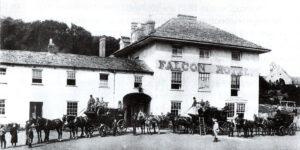 Stagecoach picture 1904 – the leading coach with young Tim Thomas holding the lead horses and his father, William, coachman, being seen off by the owner, George Brendon.
Stagecoach picture 1904 – the leading coach with young Tim Thomas holding the lead horses and his father, William, coachman, being seen off by the owner, George Brendon.
William George Mason, the son of an ostler, was born in 1883 at 1 Marine Terrace, Bude. He married Avaline Phillips in 1926 and they had a son, Horace, in 1927. They lived at 8 Flexbury Park. William died in 1955.
Hedley Spry was married to Lily Jane Bate and they had a daughter Katie who died in 1924, on her 10th birthday. Their son, Jack, married Vera Staddon.
John Henry Hallett, born in 1879, was brought up at Morwenna Terrace. His father, George Phillips Hallett, was a master mariner. John trained as an accountant and was the District Secretary of the Independent Order of Rechabites. He married Hilda Ball from Cambridgeshire in 1901 and they adopted a daughter, Mabel Hallett Whitney from Chiswick, London.
In 1926 Mr Hedley Spry purchased a controlling interest in the business of Edwards and Son and new premises with sales, workshops and petrol pumps were built at Burn View. When the new cinema at the top of Belle Vue opened in 1936, Edwards and son purchased the old cinema at the end of Burn View which they use as a garage. Thomas Edwards died in the Prince of Wales hospital, Plymouth, in 1944 aged 70.
 Tom Edwards’ garage in Burn Vue – now the Co-op supermarket.
Tom Edwards’ garage in Burn Vue – now the Co-op supermarket.
The last three children of John and Ann Edwards were all girls. Ellen, born in 1878, married George Henry Moyse and they had two sons. Emily, born in 1880, married Samuel John Henry Snowden in 1905 and had two sons. Katie, born in 1883, married Daniel Pooley from Bush in 1908: they had a son – Daniel John. Daniel senior worked for the Knights at Poughill Mill and was killed in France on the 5th of April 1918 aged 34. He is remembered on a foundation stone at Poughill Chapel. Katie lived at Woodbine Cottage, Poughill, and died in 1967 aged 84, and is buried in Poughill Churchyard.
John and Ann are both buried at St Michael and All Angels, Budehaven.
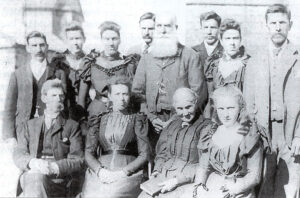 John and Ann Edwards, circa 1900, with ten of their children
John and Ann Edwards, circa 1900, with ten of their children
Footnote:
The photos accompanying this article are part of the authors collection.
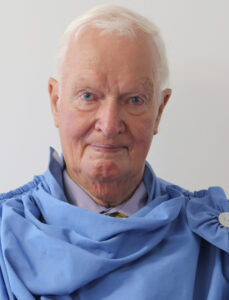
Alan McIntosh is a former President and current Recorder of Bude Stratton and District Old Cornwall Society, the most northerly branch of the Federation of Old Cornwall Societies. Alan was made a Bard of Gorsedh Kernow at Padstow in 2023 taking the name Amaler an Kledh (Borderer of the North)

So enjoyed all this history as my father Samuel Fry worked for Pethicks builders from the age of 14 to 64 and took great pleasure in talking of all the local buildings he was involved with – including Bude Post Office.
I found this to be a very interesting article and mentioned so many Bude street names. Where was Orthello Terrace as I can’t recall there being one now.
I was fascinated reading this story. I have a copy f the “stagecoach picture 1904” handed down from my father Peter Sillifant. He has written underneath that his grandfather is driving the first, North Cornwall, coach: and “my dad standing second from left (long coat)” His dad was William Thomas (Tim):Sillifant; and his grandfather William Henry Sillifant. It seems more likely that the boy my dad identified is Tim Sillifant than the one holding the horses’ heads. That boy appears too old.
William Henry appears in the middle of a photo of three men standing by a Morwenna Grey charabanc that was on the former Bude and Beyond website. Thomas Edward’s is on the left, William Henry in the middle, and William Thomas Sillifant on the right.
Tim Sillifant served in the DCLI during the First World War on the Western Front, and on his return bought a house in Fairfield Road which he named “ Laventie” after the small French town behind the front lines which his battalion used as a rest area.
During the Second World War Tim became a Special Inspector in Cornwall Constabulary, helping protect the people of Bude
I had no idea this page existed and I’m glad it does. Today I learned that my gradfather was the first baby cristened in the font at Flexbury Chapel.
My father was Arthur John Edwards. His father James Henry Edwards remarried
a lady called Aunt Julia and they lived in Harlesden, London. Arthur joined them there and was articled to a firm of Solicitors in Wealdstone,(the same firm as WS Gilbert what worked for.)
Fascinating for me as these are my family and I have learnt a lot from your article. Thank you. I remember Cousins Annie, Harold and Gladys and remember visitin Kate Pooley as a child.
James Henry Edwards married for a second time a lady I remember being called Aunt Julia, they lived in Harlesden, London. My father Arthur John Edwards joined them there and was articled to a law firm in Wealdstone.